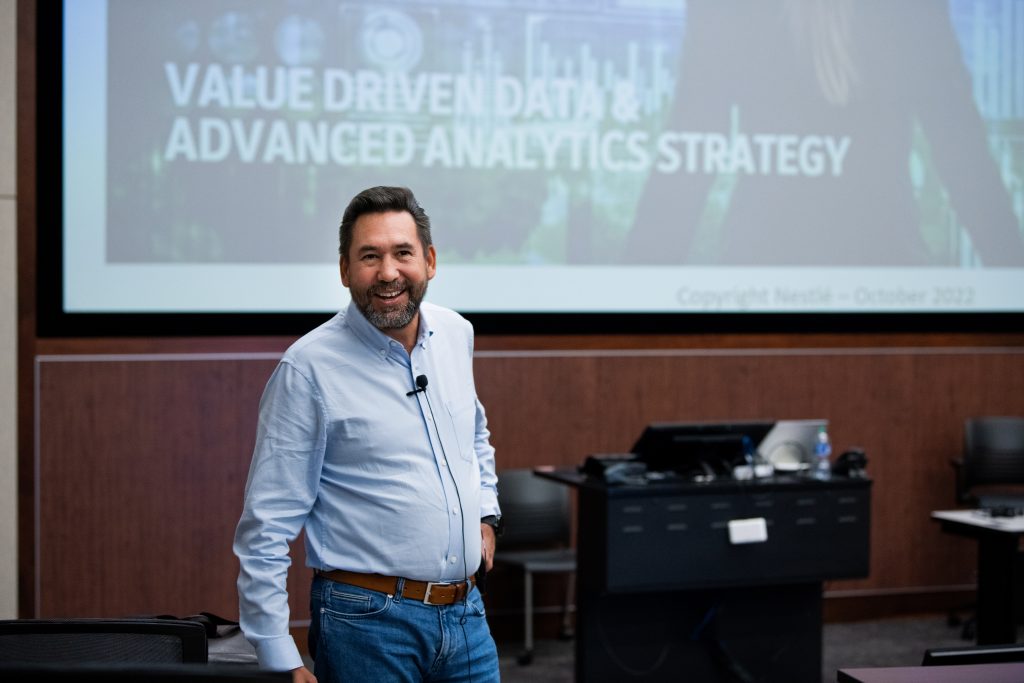To kick off the symposium, Luckie and Co. Senior VP of Business Intelligence and Integrated Solutions Brian Lamkin and Lead Analyst Margaret Mason presented on The Problem with Relevance. Using Brian’s wife as an example, they illustrated the challenges of companies using data to drive marketing. They showed that while 3/4 of customers find detailed profiles valuable if they allow more personalization of the buying experience, the customers still demand that companies “show me that you know me”–they want content and products that are relevant to their real interests and needs. Additionally, the presenters said that the marketing tech stack has grown 5000% in the last ten years, and 98% of companies claim to be “data-driven,” while a mere 40% have adopted best practices. Ideally, business data should tell you “where, when, or how you will win.”
ProcureVue CEO & Founder Cameron Jagoe presented on A Certain Business Case for Analytics During Uncertain Times. He asked, “what would you do differently if you knew the future?” Would you invest in masks before Covid-19? Divest real estate before the 2008 real estate collapse? While it’s not possible to know the future per se, Jagoe argued that by following the OODA loop decision-making model (Observe, Orient, Decide, and Act) and iterating quickly, executives and business leaders could respond to changing conditions quickly enough that it would seem as if they were looking into the future. He drew upon examples as diverse as airborne dogfighting in the Korean conflict; employee empowerment in Toyota factories; and the unexpected resilience of Ukraine in the current Russia/Ukraine conflict.
Data Science Profession: Required Skills and its Usage in the Insurance Sector was the title of Protective Life Corporation Chief Data Scientist Dr. Raja Chakarvorty’s presentation. After showing showing that data has been used in decision-making as early as 1858 with Florence Nightingale’s Rose Diagram, Chakarvorty offered an overview of the role of data science within the insurance industry. He then provided example skillsets expected of data scientists, such as ethics, business knowledge, data visualization and business concepts, as well as common coding languages data scientists should know (hint: if you are heading for a data science role, brush up on Python and SQL now). He reminded the audience of the importance of ROI vis a vis analytics: business only cares about whether the work is translating into dollars.
Bart Masters, who is Director, Data Science at Greenlight Financial Technology, Inc., presented on Data Science at Greenlight: Growing with our Families. He reflected on his experiences as a leader of a small, fairly new team within a growing fintech company. Composed of mainly machine learning practitioners, Masters’ team is accountable to strict ethical standards, especially since their work affects families and children. For Masters, his team’s directives can be distilled to three items: “Move fast. Tell stories. Make impact.” Moving fast means showing application of data products and being able to pivot quickly; data storytelling focuses on context and action, not just data points; and making an impact involves creating measurable results that drive organizational KPIs.
Presenting on Building the Intelligent Supply Chain, Accenture Managing Directors, Applied Intelligence Ryan Anderson and Dr. Rubina Ohanian highlighted the ways data analytics can impact supply chains, especially in the wake of Covid-19 disruptions. The presenters drew on “six signals” that are “essential to the future success of supply chain organizations”: proactively anticipating the future; decentralizing decision-making; building in sustainability; breaking physical limits of supply chain fulfillment; embracing virtual goods, environments, and prototypes; and becoming scientific (data-driven) companies. “There is nothing we do today from a methodology perspective that we didn’t know 30 years ago,” Ohanian argued. “What changed was speed of tech.” However, most companies still suffer from incomplete or inaccurate data.
Culverhouse Assistant Professor of Economics Dr. Erik Johnson, who is also CEO of several AI/ML-based startups, presented on Using Analytics to Detect Blight and Enforce Codes in Cities. He recounted how his interest in helping communities in tangible ways led to his work in AI and ML, and how his conversation with Tuscaloosa city officials revealed a community concern about urban blight. Using ML imaging technologies, Johnson and his team were able to develop a solution that attaches cameras to garbage trucks, which then take photos of residential properties throughout the city. The ML algorithm compares the photos to an international database of residential issues, from overgrown weeds to cracked paint, and weighs them against a community-specific urban blight scale. Communities are then empowered to respond before blight worsens in specific areas.
Finally, Nestle’ USA Vice President, Data and Advanced Analytics Octavio Flores presented on Value-Driven Data and Advanced Analytics Strategy. After providing a brief history of the Nestle’ corporation, Flores turned his attention to the company’s social values, including sustainable nutrition, climate change, packaging and plastics, and improving livelihoods. Finally, he discussed analytics strategies to maximize data analytics value at scale. The four pieces of an advanced strategy included democratizing data; generating “always-on” insights; scaling AI across the entire enterprise; and scaling analytics innovation. Flores emphasized that data scientists must stay at the cutting edge. “If I’m not strategic on what’s next (next 24-36 months),” he said, “I will become irrelevant.”
Mr. Flores was not available to be interviewed.

This website uses cookies to collect information to improve your browsing experience. Please review our Privacy Statement for more information.